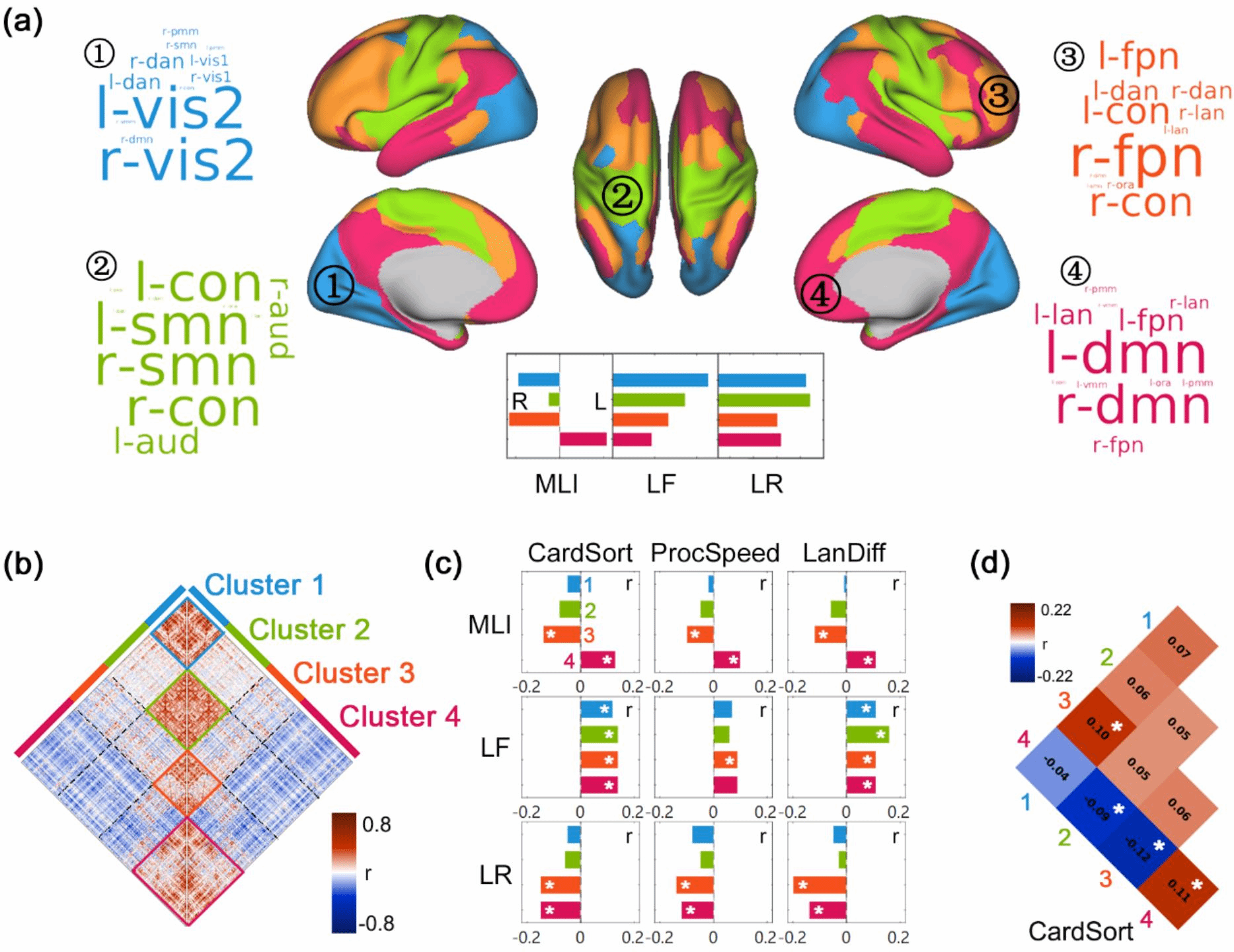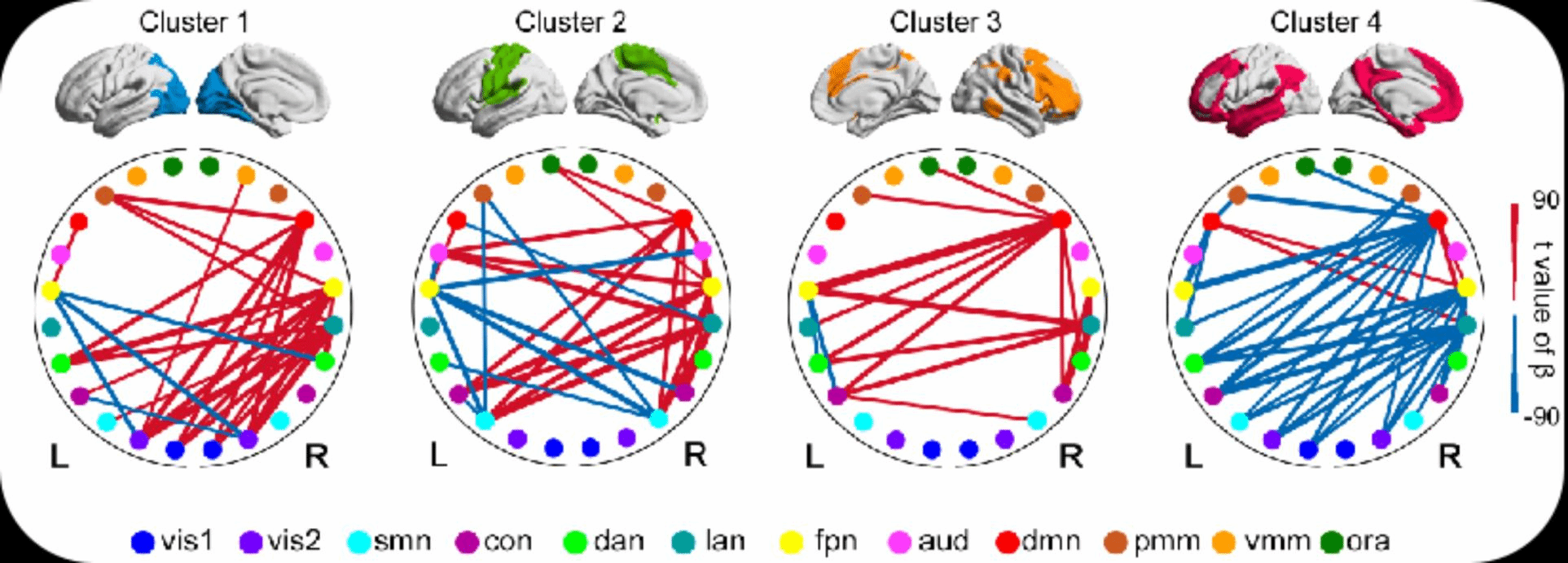On Mar 17, 2022, a paper entitled “Dynamic changes in brain lateralization correlate with human cognitive performance” was published online in PLOS Biology by Prof. Jie Zhang’s group at the Institute of Science and Technology for Brain-Inspired Intelligence, Fudan University.
Hemispheric lateralization is a prominent feature of human brain organization(Toga & Thompson, 2003). For example, the left hemisphere is critical for language, while the right hemisphere plays a key role in spatial attention. Although this functional lateralization is traditionally considered a static feature of brain network organization, recent evidence also suggests the “dynamic” nature of intrinsic brain networks over time(Bassett & Sporns, 2017): the brain needs to constantly change its connectivity patterns among different modules in order to adapt to changes in the environment. Therefore, it is possible that lateralization also changes across time, which was previously not explored.
To solve this problem, Zhang and his team combined the sliding time window dynamic connectivity approach with a global-signal based laterality index and proposed an innovative Dynamic Laterality Index (DLI), which captures the time-varying changes of brain laterality. Specifically, theDLI is defined as the difference between an ROI’s signal correlation with the global signal of left brain and its correlation with the right brain at each time window(Fig 1a). Subsequently, the authors defined two indicators to characterize the dynamic changes in laterality (Fig 1d):the magnitude and the sign of laterality, termedlaterality fluctuations(LF) andlaterality reversal(LR). LF is defined as the standard deviation of laterality time series, while LR refers to the number of zero-crossings of laterality (switch between left- and right-laterality) in two consecutive windows. In addition, both spatial and temporal clustering of the laterality time series of the whole brain were performed in order to obtain the highly synchronous spatial communities and the repeated states of lateralization (Fig 1b&c).

Figure 1. Theworkflow of dynamic laterality analysis.
Based on high-quality MRI data from 991 healthy young adults in the Human Connectome Project (HCP), Zhang and his team found that dynamic lateralization of the brain has the following characteristics:
1)Higher-order brain regions (default/language/attention network) and lower order regions (such as visual and sensorimotor network) show opposite dynamic pattern of lateralization, where low-level regions showlargerdynamic fluctuations and reversals, while the higher order regions show smaller fluctuations and reversal. The LF of higher order regions was positively correlated with language function and cognitive flexibility, while the LR was negatively correlated with these abilitie. Previous literatures suggested that comprehending literal meanings was associated with left language areas, while dealing with difficult metaphors were shown to involve the right homotopic regions(Helton et al., 2010). Greater fluctuations of laterality therefore suggested larger number of states of intra- and inter-hemisphere interactions, which may involve both left-hemisphere language areas and the right homotopic regions that may be beneficial for difficult language tasks. However, too much involvement ofthe right hemisphere (i.e., frequent laterality reversal) willcauseinterference with the leftlanguage areasthushampers language function. These results suggest that the dynamic balance between the segregation and integration between hemispheres is critical for cognitive functions.
2)There is a temporal synchronization pattern among the lateralization time series of each brain region. The higher order regions show an opposite trend (negative correlation) with the low order regions, and the more negative correlation is associated with better cognitive performance. These results could be explained by the causal hypothesis of hemispheric specialization which states that lateralization of one function forces the other function to the opposing hemisphere, which optimize parallel processing in complex tasks and increases processing efficiency(Cai, Van der Haegen, & Brysbaert, 2013).
3)The dynamic change of lateralization is related to the change of the functional connections of higher-order networks, and is related to local energy consumption, modularization and structural connection. Functionally, greater lateralization of higher-level brain regions was associated with disconnections to the contralateralhemisphere, lower BOLD activity of the whole brain and greater network segregation, suggesting less exchange of information across hemispheres which may be related to less energy consumption(Rogers, 2014; Vallortigara, 2006). The LF and LR are related to the structural connections, suggesting that white matter connections may be the structural basis of dynamic lateralization.

Figure 2. Spatial clustering of laterality dynamics.(a) Four spatial clusters revealed by clustering of the laterality time series of all 360 brain regions. (b) The laterality correlation matrix across 360 brain regions (averaged over all 991 subjects). (c) The correlation between the three dynamic laterality measures of the four spatial clusters and cognitive performance of three tasks. (d) The association between the laterality correlation within/between clusters and the processing speed.

Figure 3. Association between dynamic laterality time series of the 4 identified clusters and the dynamic functional connectivity within/between 24 subnetworks.
In this study, a new method, dynamic lateralization index, was used to characterize the dynamic characteristics of brain lateralization, which can help researchers to understand the lateralization and its potential association with cognitive ability from a new perspective. In the future, this method can be applied to cognitive tasks and data from psychiatric disorders (such as schizophrenia and autism) to reveal lateralization dynamics during performance of cognitive tasks and the potential abnormality of lateralization dynamics in psychiatric disorders.
JZ was supported by Science and Technology Innovation 2030 - Brain Science and Brain-Inspired Intelligence Project, Shanghai Municipal Science and Technology Major Project and NSFC, and ZJLab. The first author of the present study is Xinran Wu, a Ph.D candidate from the Institute of Science and Technology for Brain-Inspired Intelligence (ISTBI) at Fudan University. Deniz Vatansever of ISTBI and Xiangzhen Kong from the Department of Psychology and Behavioral Sciences are co-first authors. The corresponding author is Prof. Jie Zhang of Fudan University.
Article link:https://journals.plos.org/plosbiology/article?id=10.1371/journal.pbio.3001560
Reference
Bassett, D. S., & Sporns, O. (2017). Network neuroscience.Nature Neuroscience, 20(3), 353.
Cai, Q., Van der Haegen, L., & Brysbaert, M. (2013). Complementary hemispheric specialization for language production and visuospatial attention.Proceedings of the National Academy of Sciences, 110(4), E322-E330. doi:10.1073/pnas.1212956110
Helton, W. S., Joel, S. W., Lloyd, D. T., Gerald, M., Raja, P., & Peter, A. H. (2010). Cerebral lateralization of vigilance: A function of task difficulty.Neuropsychologia, 48(6), 1683-1688.
Rogers, L. J. (2014). Asymmetry of brain and behavior in animals: Its development, function, and human relevance.Genesis, 52(6), 555-571.
Toga, A. W., & Thompson, P. M. (2003). Mapping brain asymmetry.Nature Reviews Neuroscience, 4(1), 37-48.
Vallortigara, G. (2006). The evolutionary psychology of left and right: costs and benefits of lateralization.Dev Psychobiol, 48(6), 418-427. doi:10.1002/dev.20166
Vatansever, D., Menon, D. K., & Stamatakis, E. A. (2017). Default mode contributions to automated information processing.Proceedings of the National Academy of Sciences, 114(48), 12821-12826.

